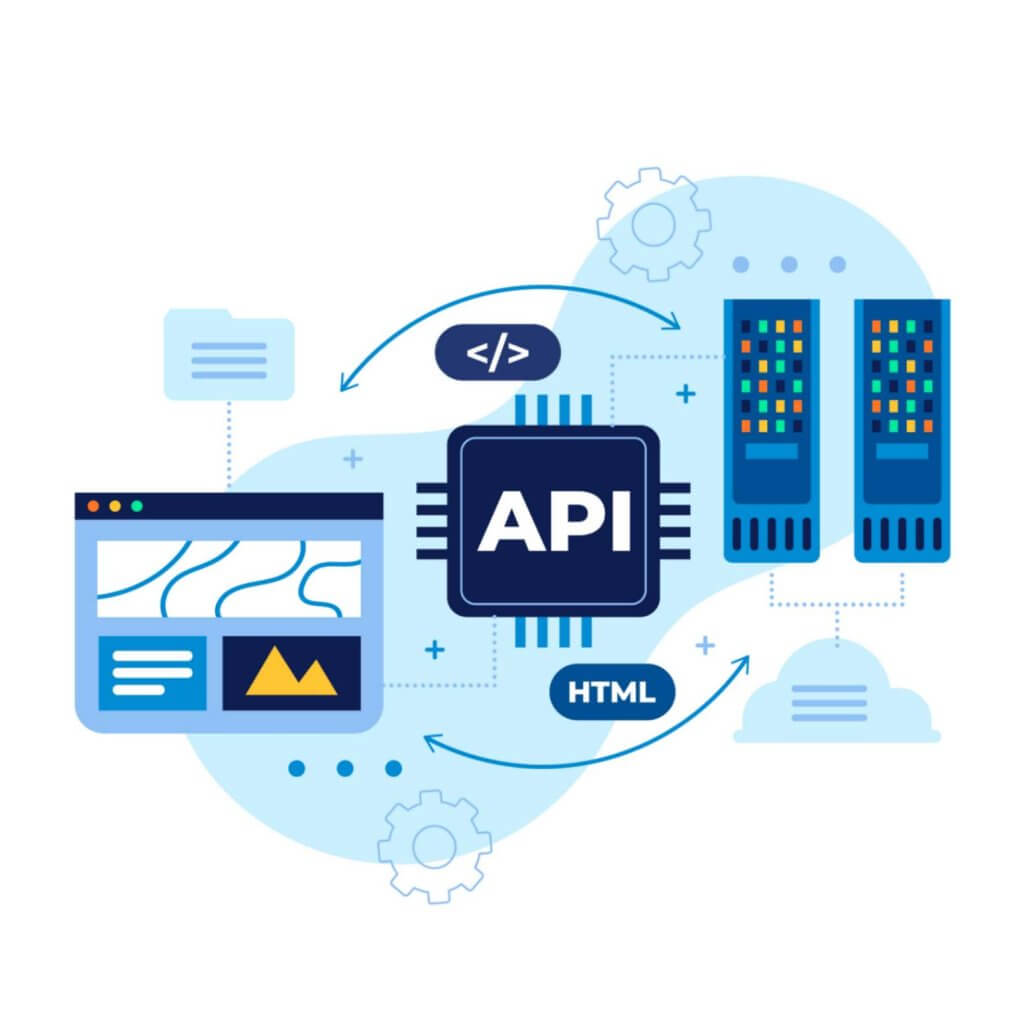What is an API?
Application programming interface, or API for short, is a collection of definitions and protocols used to create and integrate application software.
An Application Programming Interface (API) is an essential element of a successful e-commerce business. It provides customers with a more seamless experience and allows businesses to exercise more control over the customer data they collect and utilize. With the right API, businesses can keep up with customer demand and stay ahead of the competition.
Importance of having an API
1. Streamline Your Business Performance
You may save time and effort by automating many of the procedures that go into running a successful e-commerce business with the proper API. With the ability to customize your API to your business requirements, you can manage inventory, pricing, orders, and more without having to manually enter any information.
It is also simpler to track performance indicators and determine success when using an API. This makes it simple to spot places where procedures need to be improved or changes need to be made to enhance the customer experience.
2. Increase Security for User’s Data
Your business benefits from an additional level of security when using APIs. You may manage who has access to sensitive data in your store and monitor its use by connecting an API.
Using an API gives your business the authority to revoke access if necessary, preventing unauthorized users from seeing or utilizing your customers’ private data. APIs also assist in defending you against malicious actors by adding a layer of authentication that is challenging for hackers to defeat.
3. Improve Customer Satisfaction & Retention
How do you live up to the high expectation your customers have for a more individualized purchasing experience? Having an API offers your businesses the chance to improve the efficiency and convenience of your customers’ shopping experiences.
Switching between a customer’s desktop, mobile, and other devices is simple and doesn’t need them to enter information again or lose their place in an order. APIs can be utilized as a way to swiftly make adjustments or corrections on behalf of a client, eliminating the additional labor (and time) necessary to guarantee customer happiness.
4. Foster Innovation & Tap Into New Markets
APIs open doors to expanding product offerings fast and easily, customizing solutions, or exploring new markets. Since APIs make connected operations more efficient, you can concentrate on innovation rather than labor-intensive manual processes, which leads to these types of efforts all contributing to continuous competitive advantage.
Through the use of an API, operational processes can be unified, streamlining and lowering costs. This enables you to concentrate on making improvements to your company while keeping the demands of customers in mind.
5. Enhance Your Brand Reputation & Image
An API gives off a professional image of dependability, stability, and security and makes your e-commerce firm noticeable. Direct integration with other websites, marketplaces, or accounting software rapidly reinforces the idea that you are in a superior position to the competitors.
As a result of your brand’s self-evident reputation for superior technology, capabilities, and customer service, more people will be inclined to trust it. As credible third parties frequently promote apps connected to their company, granting access to an API to outside developers can increase brand recognition even more.
Types of APIs
Partner APIs
Partner APIs are types of API that facilitate business-to-business activities. This form of API is made available to specific or authorized business partners and developers to enable them to connect to selected internal resources and data systems. Partner APIs typically include higher security, authentication, and authorization controls.
Internal APIs
An internal or private API is only meant to be used inside the company to link together systems and data. For instance, an internal API may link the accounts, sales, marketing, HR systems of an organization, etc.
Because they are designed for internal usage, security measures are presumed to be in place through other policies, internal APIs typically feature inadequate security and authentication — or none at all.
Public APIs
Public APIs are comparable to open APIs, although they frequently charge a fee. That also means that they typically include some sort of key for authorization or authentication to keep track of usage. Public APIs frequently use a freemium model.
Due to the fact that they are created with the general public in mind, public APIs are frequently among the strongest and most advanced. They are also essential for gaining access to some of the advantages of APIs, such as revenue and brand awareness. According to Google’s most recent State of the API study, these are just a handful of the reasons why 31% of API developers rank making APIs publicly accessible as their top priority.
Open APIs
Open APIs are completely free and accessible to the whole public. For them, authorization is not necessary to access or retrieve data.
Open APIs are good for testing, learning, and research. However, there is also a staggering amount of high-quality material that can be accessible for free. Many free APIs are as least as good as their expensive or paid versions.
Unified APIs
Similar to composite APIs, unified APIs combine various APIs and back-end resources into a single API. These APIs aggregate or combine APIs to common functionality from specific industries, for Example. Banking or CRM software.
Unified APIs may present some logistical challenges and security issues. These factors must be taken into account by unified API providers, who might provide more abstraction levels and field-level encryption, for example. In reality, many SaaS financial systems use unified APIs. Consider the payment processor Stripe, which can receive funds from almost any source.
Composite APIs
Composite APIs combine many API calls into a single API call. This not only reduces data usage but also increases the effectiveness of your program by limiting the number of API calls.
Applications that are commonly grouped together benefit from composite APIs.For Example, when creating a user account for an application, there can
be multiple requests like creating usernames, new orders, checkouts, etc.
Read also: Digital Marketing Trends

API Protocols
- Simple object access protocol (SOAP): Extensible markup language (XML) powers API conversations in the SOAP API protocol. The earliest protocol that is still in use today is SOAP, which was launched in June 1998.
XML files are generally used by this protocol to send data through HTTP or HTTPS connections. However, it is also adaptable enough to transfer data across various protocols, such as user data protocol, transmission control protocol, and simple mail transport protocol (SMTP) (UDP).
- Representational state transfer (REST): Compared to SOAP, REST protocols are more adaptable. This is mostly done by eliminating XML’s dependence; JSON is a prominent format used by REST to convey data. However, it can also transport data in many other formats, such as plain text, HTML, Python, and even media files.
A RESTful API is one that makes use of the REST protocol. These APIs operate on a client-server model. REST is less flexible on this front because it can only communicate through HTTP and HTTPS, unlike SOAP.
- Google remote procedure call (gRPC): gRPC is an open-source remote procedure call (RPC) architecture that was created by Google and made available for general usage in 2015. It can function in a variety of contexts.
The HTTP protocol is largely used by the gRPC transport layer. An important aspect of gRPC is the flexibility for developers to specify custom functions that permit adaptable inter-service communication.
Capabilities offered by this API protocol include timeouts, authentication, and flow control. Data is delivered in protocol buffers, a technique that is independent of platform and language and enables logical data organization, in the gRPC protocol. The service is defined by this mechanism, followed by the data structures it will employ. The protocol buffer compiler handles compilation.
- JavaScript object notation–remote procedure call (JSON-RPC): Using request objects and response objects, JSON-RPC is a stateless and compact API protocol that connects online services. JSON-RPC, which was introduced shortly after the year 2000, makes use of JavaScript Object Notation (JSON) to enable the straightforward, if constrained, execution of API connections.
Read also: What is Inbound marketing
This protocol specifies requests that, given its limited parameters, can handle all functionalities. When used properly, JSON-RPC has the ability to perform better than REST.
- Graph query language (GraphQL): Developed at Facebook and released in 2015, GraphQL is a server-side runtime for APIs. Giving consumers the precise data they seek, no less, no more, is the protocol’s top priority by design. GraphQL facilitates the development of quick, adaptable APIs, including composite APIs, and is user-friendly for developers. REST can be replaced with GraphQL.
- Apache Thrift: Thrift is a lightweight language-independent software stack created by Facebook. This API protocol offers binary transport types in addition to HTTP transmission. For data serialization, transport, and application-level processing, Thrift can provide clear abstractions and implementations. Implementing point-to-point RPC is its main goal. Programs created in any of the 28 programming languages that Apache can support can interact with one another and make API requests for remote services.






